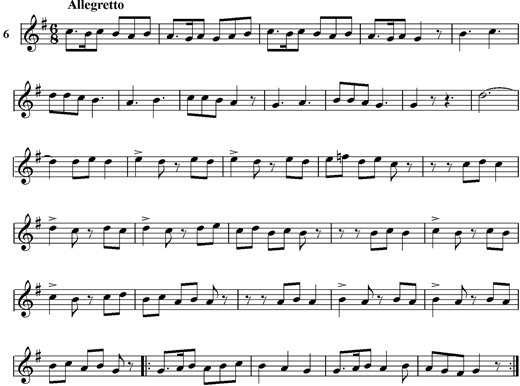

APPENDIX
Structural Pecularities
Unlike the ordinary direction (upward from below. i. e. from "Maye-Rast" to "Iraq" (as to culmination), this song has a direction downward from above, i.e. from "Iraq" to "Maye-Rast".
The 1-st phrase refers to the section "Iraq", it ends in the beginning of the 2-nd bar in the octave of the tonic, which is a sign of its reference to the section "Iraq".
The 2-nd phrase conditions the transition to the section "Garayi" with a stop in the beginning of the 4-th bar in the quinte of the tonic. These two phrases form the 1-st four-barred sentence. The response sentence also consists of two phrases and ends in the tonic third in the beginning of the 8-th bar. Corresponding phrases (1-st with the 1-st, 2-nd with the 2-nd) of the initial and return sentences are constructed symmetrically. Instead of the ordinary repetition of the response phrase there comes an independent sentence, the 1-st phrase of which is the repetition of the 2-nd phrase of the response sentence with some small changes. However, the 2-nd phrase in the beginning of the 4-th bar of this sentence leads to the tonic. Then there follows preparation for the section "Vilayati" expressed with one tone (quinte of the tonic) along two bars. The section "Vilayati" consisted of 2 three-barred sentences, the 2-nd of which is the precise repetition of the 1-st, follows later on.
In the end of the final bar of the 2-nd sentence there follows a gamma-like move, which links "Vilayati" with "Husseyni". The latter is a section, which leads to the tonic (completion of the songs). It also consists of 2 three-barred sentences, the 2-nd of which is the precise repetition of the first one.
The second example "Arazbari" from "Rang" is constructed in the mode "Shur" with the tonic re.
Structural Peculiarities
Structure of this example, of its metrical and rhythmical arrangement of phrases and their harmonical correspondence (as a question and its response), submits great freedom. This freedom is in frequent repetition of the content of one bar and in deviation from the structure of the other. Phrases generally form the rhythmical theme of composition by rhythmical structure . For example, the initial phrase related to the section of "Shur-Shahnaz":
It also begins with a pause. But in the second example the response phrase has not got a pause, for instance:
Besides, this response phrase appears not in the 3-rd bar, as always, but in the 5-th bar, as the 3-rd and 4-th bars are occupied by repetition of the 2-nd bar content. The response phrase of the initial one in the section "Bayati-Kurd" (27-th bar) follows the 6-th bar instead of the third bar, as usual.
"Arazbari" starts in the section "Shur-Shahnaz". The 1-st sentence ends in the main tone third (6-th bar). After the repetition of the 1-st sentence the response sentence (12-th bar) follows. It ends in the mode tonic of "Shur" (19-th bar). The response sentence is exactly repeated and further assumes the form of a refrain. The section "Bayati-Kurd" starts in the 27-th bar. The 1-st sentence of this section is repeated note for note. The response sentence (41-st bar) ends with the upper quarte of the tonic (47-th bar).Instead of the response sentence being repeated, an independent sentence with an end in the main tone third (52-nd-53-rd bars) is allowed. Then the above-mentioned refrain follows. The final section "Zamin-Khara", which begins in the 70-th bar and forms a period with conclusion in the main tone third, and then the refrain is repeated twice again.
In the next example we should indicate only modes and sections.
"Rang" in the mode "Rast" with the tonic sol.
[ Appendix: pages 1 2 3 4]

